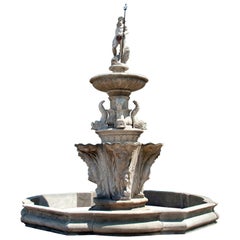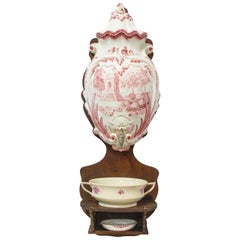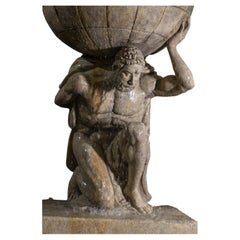Early 19th Century Fountains
1
to
1
1
1
1
4
2
1
1
2
5
2
2
2
Height
to
Width
to
1
1
1
1
Style: Baroque
Period: Early 19th Century
19th Century Large Circular Garden Fountain Neptune, Italian Limestone Fountain
Located in West Palm Beach, FL
Monumental antique Italian three-tiered garden fountain. Four Cariatidi surround the center base raising the water which spells from the waved shells. The second tier is supported by...
Category
Italian Baroque Antique Early 19th Century Fountains
Materials
Limestone
Related Items
French Faience Wall Fountain, 19th Century
Located in Labrit, Landes
Wall fountain set: original water tank and soap dish and wooden support, lavabo.
France, mid-19th century
Unseal plant holder
Very good condition
Shipping:
86 x 18 x 30 cm, 7 kg.
Category
French Antique Early 19th Century Fountains
Materials
Chestnut, Faience
Rare Antique Large Fountain - Luxury Reclaimed Italian Limestone Statue Fountain
Located in Costa Mesa, CA
In 1927, a team of master carvers from Palermo, Italy were tasked to create an exceptionally phenomenal limestone fountain for a noble Milano family estate. Within 14 months they completed the job by hand-carving a very unique and large pool fountain...
Category
Italian Classical Greek Vintage Early 19th Century Fountains
Materials
Limestone, Wrought Iron
Free Shipping
H 124 in Dm 210 in
19th Century Portuguese Marble Wall Fountain
Located in Vosselaar, BE
A large 19th century Portuguese wall fountain. Finely sculted in Verona marble with a moulded star inlayed plint above the lobbed basin resting on a baluster plint. The dolphin snout...
Category
Portuguese Antique Early 19th Century Fountains
Materials
Marble
Whimsical English 19th-20th Century White Marble Figural Outdoor Dog Fountain
Located in Los Angeles, CA
A Whimsical English 19th-20th century white marble figural fountain with dogs fountain. The Baroque Revival six-sided tripod marble base surmounted with three upright seated Yorkshire Terriers resting on a leaf and acanthus center stem, topped with a semi-circular scalloped carved basin...
Category
English Baroque Revival Antique Early 19th Century Fountains
Materials
Marble
H 60.63 in W 30.5 in D 28.5 in
Italian 19th-20th Century Whimsical White Marble Wishing Wellhead with Children
Located in Los Angeles, CA
A very fine and exceptionally carved Italian 19th-20th century Baroque Revival style whimsical white Carrara marble wishing wellhead, raised on an octagonal two-step marble base. The intricately carved marble relief circular wellhead depicting carved figures of dancing and cheerful children (Putti) among vines, flowers and fruits, dancing and playing musical instruments with a backdrop of castles, landscapes, forests and wreaths, Florence, circa, 1900.
Literature:
A similar wellhead was sold by Jan's & Co. Fine French Antiques, Inc. in 1999, provenance the Atkinson/Kirkeby Estate and it is illustrated in "The Estates of Beverly Hills" by Charles Lockwood and Jeff-Hyland, page 150.
Another similar is currently on display at the gardens of "The Elms" mansion a public museum part of the Newport Mansions by The Preservation Society of Newport County in Newport, Rhode Island.
Yet another similar wellhead carved with frolicking putti with musical instruments and a dentil molded rim is located at Cranbrook House, Bloomfield Hills, Michigan, and is illustrated in B. Israel, Antique Garden Ornament...
Category
Italian Baroque Revival Antique Early 19th Century Fountains
Materials
Carrara Marble
Large Indoor Ceramic Wall Fountain From Sarreguemines 19th Century
Located in charmes, FR
fountain in three parts in green and brown slip. - the backsplash is decorated in relief with dolphins and a lion's muzzle (a brass tap will be included) - the basin is decorated wit...
Category
French Napoleon III Antique Early 19th Century Fountains
Materials
Ceramic
Marble Fountain Basin, 19th Century
Located in Greding, DE
Round marble fountain basin on conical shaft and square plinth and discreet leaf frieze on the tulip-shaped wall.
Category
European Neoclassical Antique Early 19th Century Fountains
Materials
Marble
19th Century French Marble and Bronze Fountain
Located in Essex, MA
19th century French marble and bronze fountain. Seated satyr on marble column with marble shell basin. Later cast stone plinth. Wonderful garden ele...
Category
French Louis XV Antique Early 19th Century Fountains
Materials
Marble, Bronze
Large French 19th Century Cast-Iron Fountain Figure of a Seated Nude Maiden
By J.J. Ducel Me de Forges 1
Located in Los Angeles, CA
A Fine and Large French 19th Century Cast-Iron Fountain Figure Modeled as a Nude Maiden Seated on a Rocky Outcrop Holding a Cornucopia in Her Raised Right Hand, by J.J Ducel. Cast-Signed "J.J. DUCEL Me de FORGES, PARIS". Circa: Paris, 1880.
A retailer of fine cast-iron ornaments, J. J. Ducel was recorded as supplying cast-iron works through Paris as early as 1810 in the Pas-de-Calais. The factory was sold in 1878 to the Fonderie de la Haute-Marne and all of the firm's models were subsequently bought by the Val d'Osne foundry. However, prior to the firm's sale, critics at the 1867 Paris Exposition Universelle proclaimed that "Ducel is the great manufacturer of works in cast-iron, to whom Paris is so largely indebted for the grace and elegance that supply so many of the adornments of its streets". Ducel, Val d'Osne and other associated foundries produced both bronze and cast-iron statuary. Cast-iron is corrosive, whereas non-ferrous bronze does not suffer the same detrimental effects of weathering and is therefore a superior and more expensive material.
Height: 51 1/2 inches (130.8 cm)
Width: 22 inches (55.9 cm)
Depth: 30 inches (76.2 cm)
The foundry of Val d'Osne became highly regarded for the varied nature and quality of its castings in the second half of the 19th century. Commonly known after 1870 as simply Val D'Osne, the company was originally founded by J.P.V. André in Val d'Osne 1835 and developed rapidly, absorbing smaller foundries in the Haute-Marne area east of Paris. The foundry contributed to the London International Exhibition of 1851, where a bronze fountain cast with classical figures attracted much attention. André also specialised in fancy castings and architectural fittings. His Paris adress was at 14 Rue Neuve, Menilmontant.
In 1855 the Barbezat & Cie Foundry was born out of the André workshop. In 1867 Barbezat & Cie changed its name to Houille & Cie. Then, in 1870, it changed its name to Société Anonyme du Val d'Osne. With the change of name came the change of casting mark and adress: Fonderies d'Art du Val d'Osne, 58 Bd Voltaire, Paris or simply Val d'Osne.
Cast-iron had been in production during the 18th century but its inferior status to the more fashionable and delicate wrought-iron had generally confined its use to architectural work. By the early 19th century, however, rapid developments of the Industrial Revolution combined with the simultaneous burgeoning of a new middle class provided the impetus for a dramatic expansion in its application and in a short space of time a proliferation of iron foundries across Europe and America thrived on the production of everything from inkstands to railway stations. The use of cast-iron for garden ornament became particularly widespread at this time, as the possibilities for its mass-production at a fraction of the cost of bronze made it the material of choice for indoor/outdoor statuary...
Category
French Classical Greek Antique Early 19th Century Fountains
Materials
Iron
H 51.5 in W 22 in D 30 in
17th Century, Carrera Marble Lion Fountain Head
Located in Newport Beach, CA
Stunning, solid white, Carrara marble lions head from a fountain in Florence featuring a flowing main and a fabulous patina. Mounted on a custom, iron base. The piece hails from the ...
Category
Italian Antique Early 19th Century Fountains
Materials
Marble
Italian 19th Century Carved Carrara Marble Figural Fountain Jardinière Planter
By Giovanni Battista Lombardi
Located in Los Angeles, CA
A very fine Italian 19th century carved Carrara marble figural fountain "Jardinière" modelled as a standing Putto and a Satyr supporting a sea-sh...
Category
Italian Baroque Antique Early 19th Century Fountains
Materials
Carrara Marble
H 50.5 in W 31 in D 26 in
Italian Ancient Marble Sculpture Fountain, Late 16th Century
Located in Milano, IT
Sea monster
Carrara marble mouth fountain
Italy, late 16th century
It measures 13.8 x 31.5 x 18.9 in (35 x 80 x 48 cm)
State of conservation: some small evident gaps and widespread signs of wear due to outdoor exposure. The gray marks crossing it do not come from restoration, but are rather the natural veins of the marble.
This work has some morphological characteristics typically associated with the iconography of the sea monster: an elongated muzzle, sharp teeth, protruding eyes, elongated ears, and a coiled serpent's tail.
An in-depth series of studies on artistic depictions of the sea monster attempted to verify how this symbol evolved in antiquity in the European and Mediterranean contexts and how it gradually changed its image and function over time. The iconography itself is mutable and imaginative and its history is rich with cultural and artistic exchange, as well as the overlapping of ideas. This occurred so much that it is difficult to accurately pinpoint the "types" that satisfactorily represent its various developments.
However, we can try to summarize the main figures, starting from the biblical Leviathan and the marine creature that swallowed Jonah (in the Christian version, this figure was to become a whale or a "big fish", the “ketos mega”, translation of the Hebrew “dag gadol”). Other specimens ranged from the dragons mentioned in the Iliad (which were winged and had legs) to "ketos” (also from Greek mythology), the terrifying being from whose Latinized name (“cetus”) derives the word "cetacean". See J. Boardman, “Very Like a Whale” - Classical Sea Monsters, in Monsters and Demons in the Ancient and Medieval Worlds, in Papers presented in Honor of Edith Porada, Mainz am Rhein 1987, pp. 73-84).
In Italy the monster underwent yet further variations: it can be found in Etruscan art on the front of some sarcophagi representing the companion of souls, while among the Romans we find the “Pistrice” (cited by Plinio in Naturalis Historia PLIN., Nat., II 9, 8 and by Virgilio in Eneide: VERG., Aen., III, 427), which appeared in the shape of a stylized hippocampus or a very large monstrous cetacean and evolved into a hideous being with a dragon's head and long webbed fins.
During the Middle Ages, the sea monster was the object of new transformations: at this time, it is often winged, the head is stretched like a crocodile, the front legs are often very sharp fins - sometimes real paws - until the image merges with dragons, the typical figures of medieval visionary spirituality widely found throughout Europe (on this topic and much more, see: Baltrušaitis, J., Il Medioevo fantastico. Antichità ed esotismi nell’arte gotica, Gli Adelphi 1997).
In Italy during the 15th and 16th centuries, the revival of classicism - representative of the humanistic and Renaissance periods - led to a different reading of these "creatures". Indeed, the sea monster was also to find widespread use as an isolated decorative motif, especially in numerous fountains and sculptures where dolphins or sea monsters were used as a characterizing element linked to water (on this theme see: Chet Van Duzer, Sea Monsters on Medieval and Renaissance Maps, London, The British library, 2013).
From the morphological point of view, the "sea monsters" of this period are mostly depicted as hybrid figures, in which the body of a mythological or real being (a hippocampus, a sea snake, a dolphin), is joined to a head with a rather indistinct appearance. It was usually characterized by large upright ears, an elongated snout, sharp teeth and globular, protruding eyes; a complex and indefinite figure, both from the symbolic point of view and from that of its genesis.
The work we are examining is placed as a cross between the medieval sea serpent and the Renaissance dolphin, with stylistic features which recall the snake as often used in heraldry (such as the "snake" depicted in the coat of arms of the Visconti - the lords and then dukes of Milan between 1277 and 1447 - and which, for some, may be derived from the representations of the “Pistrice” that swallowed Jonah).
In the search for sources, Renaissance cartography and in particular woodcuts should not be neglected. See for example the monsters of Olaus Magnus, from the editions of the “Historia de gentibus septentrionalibus” (“History of the peoples of the north”) and the natural histories of Conrad Gesner, Ulisse...
Category
Italian Renaissance Antique Early 19th Century Fountains
Materials
Carrara Marble
Recently Viewed
View AllMore Ways To Browse
Antique Fountain Spout
Water Trough
Watering Trough
Used Watering Troughs
Used Water Trough
Water Trough Used
Antique Cast Iron Fountain
Antique Cast Iron Fountains
Water Fountain Modern
Pedestal Basin Used
Antique Limestone Base
Garden Antique Wall Fountain
Patio Water Feature
Fountain Fountain Sink
Outdoor Garden Fountain
Fountains From Spain
Limestone Water Basin
Pedestal Basin


